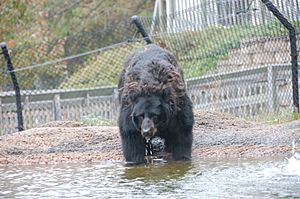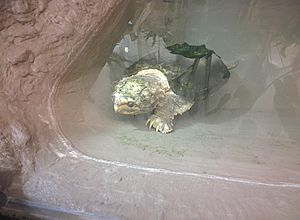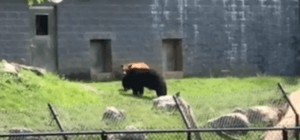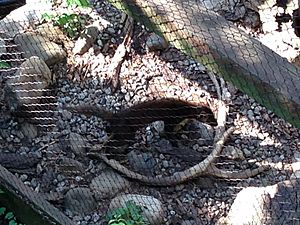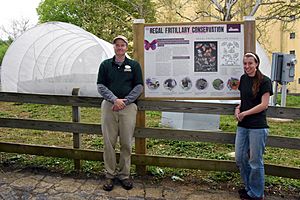ZooAmerica facts for kids
 |
|
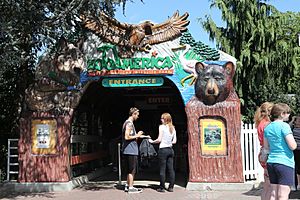
Entrance to ZooAmerica
|
|
| Date opened | 1910 |
|---|---|
| Location | Hershey, Pennsylvania, U.S. |
| Land area | 11 acres (4.5 ha) |
| No. of animals | More than 200 |
| No. of species | More than 75 |
| Annual visitors | 3.2 million |
| Memberships | AZA, WAZA |
ZooAmerica is a fun zoo located in Hershey, Pennsylvania, in the United States. It was started in 1910 by Milton S. Hershey, who also founded the famous Hershey's chocolate company. He began with just a few animals like bears, birds, and deer.
Today, ZooAmerica covers 11 acres, which is about the size of 11 football fields! It is home to over 75 different species and more than 200 individual animals. Some of these animals are rare or even endangered. The zoo is owned by the Hershey Trust Company and is connected to Hersheypark, a popular amusement park. It is also a trusted member of the Association of Zoos and Aquariums (AZA) and the World Association of Zoos and Aquariums (WAZA). This means it meets high standards for animal care and conservation.
Contents
A Look Back: ZooAmerica's History
How the Zoo Began
The story of ZooAmerica began in 1905 with 12 prairie dogs! A man named Franz Zinner couldn't keep them, so he gave them to Milton S. Hershey. Mr. Hershey thought they would be a great attraction at Hershey Park.
In 1910, Mr. Zinner gave Hershey a black bear. With more animals arriving, Hershey decided to build a proper zoo. It opened that same year with bears, birds, deer, and other animals.
Growing Bigger and Better
Throughout 1910, the zoo welcomed more animals. These included angora goats, fox squirrels, peacocks, and even zebus. By 1914, the zoo had exciting new additions like a lion, monkeys, and a leopard.
The zoo grew quickly, so in 1915, it had major renovations. New buildings were added, and all the animal enclosures were updated. By 1916, the zoo proudly displayed hundreds of animals for visitors to enjoy.
Changes Over Time
By 1934, the zoo had expanded to over 40 acres. It even had a special house for reptiles and two baby elephants. However, the elephants were later sold because visitors seemed to prefer the monkeys more!
After Milton Hershey passed away and World War II ended, the zoo reopened with new leaders. Many new animals joined the collection. These included African sheep, bison, llamas, and various birds. The zoo also created a special exhibit to teach about Pennsylvania's wildlife.
New Focus on North America
In 1971, both Hersheypark and ZooAmerica closed for big renovations. They reopened a year later with exciting new features. The zoo added a monkey island and a petting zoo with baby animals.
Six years later, John Strawbridge III became the new director. He decided to focus the zoo entirely on animals from North America. He also made sure the animal exhibits looked like their natural homes.
The new North American Wildlife Park covered 11 acres. It was divided into five cool sections: North Woods, Eastern Woodlands, Big Sky Country, Grassy Waters, and Cactus Community. In 1982, ZooAmerica earned its accreditation from the Association of Zoos and Aquariums. This was a big achievement, showing its commitment to excellent animal care.
Modern Updates and Education
In 2000, ZooAmerica opened a fantastic new bear exhibit. It had hills, grass, toys, and a large 13,000-gallon swimming pond for the bears. The next year, two rare albino alligators visited the zoo temporarily. Another one arrived in 2012.
In 2004, the zoo started a special program for kids to learn about conservation. It featured a mascot named Ranger Scratch and the Ranger Scratch Kid's Club. This club teaches kids about protecting animals and the environment. Five years later, the zoo opened the Woodlands Education Center. This building offers guests exciting hands-on experiences with animals.
Exploring the Exhibits
ZooAmerica is divided into different sections, each showing animals from a specific part of North America.
Southern Swamps: Wetland Wonders
The Southern Swamps section is the first area you might explore. It features animals from marshy, warm, and wet places. You can see animals like the cottonmouth snake, colorful roseate spoonbill birds, and tiny fiddler crabs. Other residents include the eastern diamondback rattlesnake, gopher tortoise, and the mighty American alligator.
Great Southwest: Desert Dwellers
The Great Southwest section takes you to dry, desert-like areas. It has a special part for animals that are active at night. You might spot the thick-billed parrot, Mexican beaded lizard, or a speedy roadrunner. Look out for the burrowing owl, desert tortoise, and the unique nine-banded armadillo. You can also see the black-footed ferret, ocelot, and the clever ringtail.
Eastern Woodlands: Forest Friends
The Eastern Woodlands section shows how animals adapt to the changing environments of the eastern United States. Here, you can observe the powerful red-tailed hawk and the quiet barn owl. Keep an eye out for the playful river otter, the graceful white-tailed deer, and the impressive black bear.
Big Sky Country: Wide Open Spaces
Towards the end of the zoo, you'll find Big Sky Country. This area shows animals living in vast, open landscapes. It has wide grassy plains and rocky areas that look like the bottom of mountains. You can see cute black-tailed prairie dogs, the majestic American elk, and the stealthy mountain lion. Other animals include the tall sandhill crane and the speedy pronghorn.
Northlands: Cold Climate Creatures
The last section is the Northlands. It features animals that live in cold places, from Newfoundland across Canada to Alaska. Here, you can see the beautiful snowy owl and the fast peregrine falcon. You might also spot the gray wolf, the powerful bald eagle, and the spiky porcupine. The Canada lynx also lives here, showing how animals survive in chilly climates.
Helping Animals: Conservation Efforts
ZooAmerica is very involved in helping to protect animals. They participate in the Species Survival Plan (SSP). This plan helps to manage and breed endangered animals in zoos to ensure their survival.
Currently, the zoo is working to breed animals like the thick-billed parrots, Canada lynx, black-footed ferret, and ocelots. In the past, they also helped with the swift fox SSP.
ZooAmerica has played a big part in bringing back birds like the golden eagle and peregrine falcon. These birds were once in great danger in the wild. The zoo has raised many birds of prey that were later released. One peregrine falcon they released was even found nesting along the Susquehanna River!
Since 2011, ZooAmerica has been part of a project to raise Regal Fritillary butterflies. These butterflies are then released into the wild. In 2014, two naturalists from ZooAmerica were honored for their amazing work in helping to reintroduce the regal fritillary butterfly to Pennsylvania.



